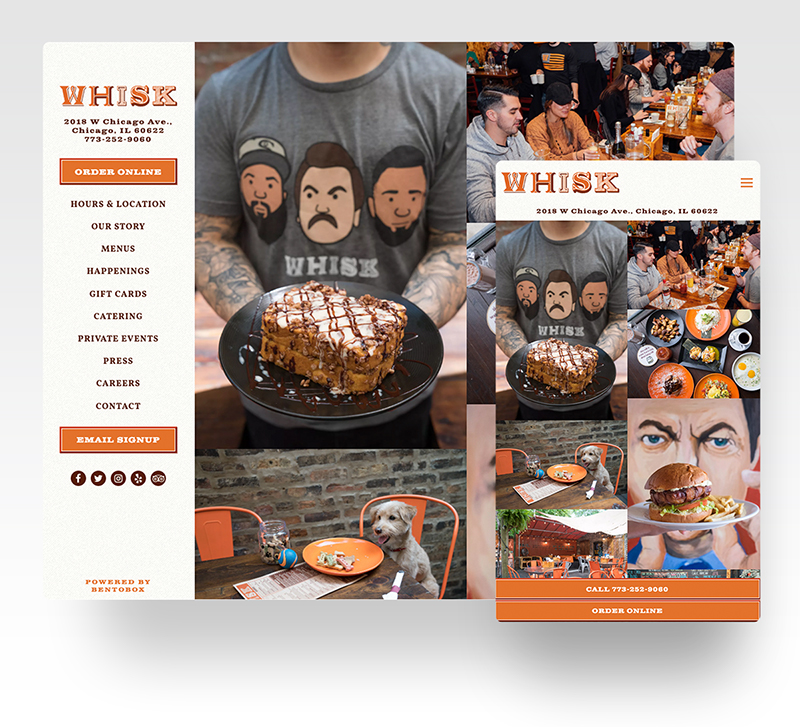A Restaurant Website Should Be Intuitive and Accessible

At BentoBox, we know restaurant websites. We know that a website should equally serve all potential guests by being easy to navigate and accessible to everyone. Whether that’s catering to those with accessibility issues (a requirement under the Americans with Disabilities Act) or simply those visitors that want quick and easy access to contact information, location or hours of operation – a functional and accessible site is essential to drive traffic to your restaurant.
In recent years, restaurants have been waking up to the importance of websites, since 77% of consumers regularly visit a restaurant’s website before making a decision on where to eat. Of those consumers, 70% have been dissuaded from dining at a restaurant because of the website. By implementing important information that is easily accessible to web visitors, you’ll create new and loyal customers.
The Hunt for Critical Information
We’ve all done it: we sift through a restaurant’s website, trying to find the hours of operation, its location(s), or even its phone number. Oftentimes it's not in any relevant section or page on the website. This can be frustrating for visitors for many reasons. Online visitors spend on average less than 15 seconds on a website before they exit, if the information they need isn’t found. That’s not a lot of time to show off your restaurant, the experience you offer, or even the information that a visitor might need to become a paying customer. There are several solutions that restaurants can implement on their websites to alleviate this pain point for their guests, no matter what device the guest uses to view the website.
The Fix on Desktop
Depending on your website’s design, the hours and location should be present throughout the visitors' online journey. BentoBox’s side navigation template on desktop creates an optimal situation for this. At the top of this side navigation, an online visitor can see the hours and location, as well as the number to contact – even while they browse through other relevant pages on the site. Going one step further, this template links the information, so that visitors can click to call the restaurant or be taken out to a maps feature. We always recommend Google Maps, as it comes as part of your Google My Business profile, which is an industry best practice to claim.

The Fix on Mobile
While the solution for viewing the website on a mobile device should function the same way, it does look slightly different than its desktop equivalent. Whisk is a great example. Their phone number is always present in a sticky button at the bottom of the screen. By clicking the button, the phone will prompt the user to call the restaurant. This is great for saving time and reducing the loss of a potential diner.
It’s also important to highlight high-margin revenue drivers, such as online ordering or reservations, which link out to third-party services that you partner with. We’re a big advocate of putting information front and center that will help your restaurant grow and prosper. The address for Whisk can be seen at the top of the screen, providing easy access to Google Maps just under the logo and “hamburger” navigation (i.e. the three-line button that expands the navigation list).
The Accessibility Fix
It’s more important than ever to ensure your website is equally serving all guests online. Designing websites with accessibility in mind has benefits and potential challenges, but it’s important to ensure that your site is an experience that everyone can equally access and enjoy.
Accessibility is part of the BentoBox approach to website design. BentoBox design best practices include guidelines on visual legibility, screen reader compatibility, motion sensitivity and more. BentoBox debuted a unique feature in its redesigned user interface that automatically generates alt-text for images that are uploaded to the site. This helps operators continue to use WCAG (Web Content Accessibility Guidelines) best practices when updating the content on their websites – and helps those with accessibility issues navigate and understand the site as well. Web Content Accessibility Guidelines (WCAG) is developed through the W3C process in cooperation with individuals and organizations around the world, with a goal of providing a single shared standard for web content accessibility that meets the needs of individuals, organizations and governments internationally.
While users may still experience challenges when navigating websites and a well-designed, accessible site is one that makes it as easy as possible for all users to find the information they need. Bad website design can make or break your restaurant’s online presence – be sure you’re working towards reducing customer loss, and effectively setting your restaurant up for success.
About BentoBox: BentoBox powers website design as part of CHECK® Business Tools. BentoBox offers a restaurant website builder and develops websites exclusively for the restaurant industry. Creating a strong website for your restaurant can help convert visitors into paying customers, while saving your business time and money. Learn more about BentoBox by visiting website design in CHECK Business Tools.
Visit the CHECK Resource Center for more articles full of valuable insights, industry analysis and helpful tools that can help you grow your business.

